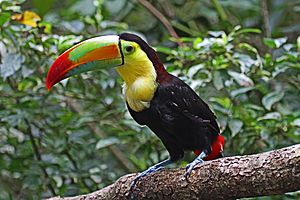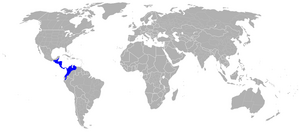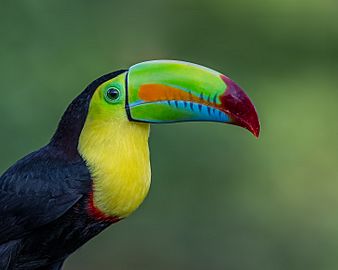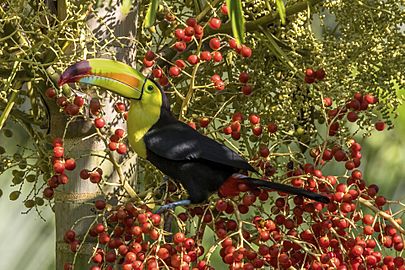Keel-billed toucan facts for kids
Quick facts for kids Keel-billed toucan |
|
|---|---|
 |
|
| Ramphastos sulfuratus sulfuratus, Belize | |
| Conservation status | |
| Scientific classification | |
| Genus: |
Ramphastos
|
| Species: |
sulfuratus
|
| Subspecies | |
|
See text |
|
 |
|
The keel-billed toucan (Ramphastos sulfuratus) is a super colorful bird from Latin America. People also call it the rainbow-billed toucan because of its amazing beak! It belongs to the toucan family.
This beautiful bird is the national bird of Belize. You can find keel-billed toucans living in warm, wet jungles. They live all the way from southern Mexico down to Colombia. These forest birds eat many different things. They enjoy fruits, seeds, insects, and even small lizards or snakes. They also eat the eggs and babies of other birds.
Contents
What are Keel-billed Toucans?
Different Types of Keel-billed Toucans
Scientists recognize two main types, or subspecies, of the keel-billed toucan:
- Ramphastos sulfuratus sulfuratus – This type was first described by René-Primevère Lesson in 1830. You can find it in southeastern Mexico, Belize, and northern Guatemala.
- Ramphastos sulfuratus brevicarinatus – This type was described by John Gould in 1854. It lives from southeastern Guatemala to northern Colombia and northwestern Venezuela.
How to Spot a Keel-billed Toucan
Size and Appearance
Keel-billed toucans are medium-sized birds. They are about 42 to 55 centimeters (17 to 22 inches) long. This measurement includes their huge, colorful bill! Their bill alone is about 12 to 15 centimeters (5 to 6 inches) long. That's about one-third of their total body length!
These birds usually weigh between 380 and 500 grams (13 to 18 ounces). Even though their bill looks big, it's actually very light. It's made of a spongy, hollow bone. This bone is covered in a tough, light material called keratin.
Feathers and Colors
Most of a keel-billed toucan's body is black. But they have a bright yellow neck and chest. They change their feathers once a year. Their feet are blue, and they have red feathers at the very tip of their tail. The bill itself is mostly green. It has a red tip and bright orange sides, making it look like a rainbow!
Special Feet
Keel-billed toucans have special feet called zygodactyl feet. This means two of their toes point forward, and two toes point backward. This special foot shape helps them grip branches very well. Since toucans spend most of their time in trees, these feet are perfect for climbing and jumping.
Where Keel-billed Toucans Live
Their Home Environment
You can find keel-billed toucans in many countries. They live from Southern Mexico all the way down to Venezuela and Colombia. They prefer to live in the very top parts of tropical and subtropical rainforests. These birds can live at high altitudes, up to 1,900 meters (6,200 feet) above sea level.
Sleeping Habits
Keel-billed toucans sleep in holes inside trees. Often, several toucans will share the same tree hole. This can be very crowded! To fit, they tuck their tails and beaks under their bodies. This also helps them stay warm while they sleep. The bottom of their tree holes can sometimes be covered with fruit pits from their meals.
Keel-billed Toucan Behavior
Social Life
Keel-billed toucans are very friendly birds. You will rarely see one alone. They usually fly in small flocks of about six to twelve birds. These groups fly through the lowland rainforests.
How They Fly
Their flight looks a bit slow and wavy. They flap their wings quickly a few times, then glide. When they glide, their beak points forward and dips down. Their feet are pulled up close to their body during flight. They usually only fly short distances.
Playing Together
These birds live together in groups and often share their sleeping spots. They have a family structure within their group. Toucans sometimes "duel" with each other using their bills. They also play games like throwing fruit into each other's mouths. Sometimes, one toucan will throw a fruit in the air, and another will catch it!
Reproduction and Life Cycle
Nesting and Eggs
Female keel-billed toucans lay 1 to 4 white eggs. They lay them inside a natural hole or an already-made cavity in a tree. Both the male and female toucan help care for the eggs. They take turns sitting on them to keep them warm.
Chicks and Growing Up
The eggs hatch after about 15 to 20 days. Once the chicks hatch, both parents continue to feed them. When they are born, the chicks have no feathers. Their eyes are also closed for about three weeks. They have special heel pads that help them stay comfortable on the pit-covered bottom of the nest. The young toucans stay in their nest for about eight to nine weeks. During this time, their bills grow fully. Once their bills are ready, they are able to leave the nest.
What Keel-billed Toucans Eat
The diet of keel-billed toucans is mostly fruit. They eat a wide variety of fruits. However, they also eat insects, eggs, baby birds, and lizards. Their bill, which looks big, is actually very good at picking up food. It helps them reach many fruits that other birds might not be able to get. When they eat fruit, they use their bill to break it apart. Then, they toss their head back to swallow the fruit whole.
-
A keel-billed toucan on a foxtail palm (Wodyetia bifurcata) in Belize
Keel-billed Toucans as Pets
Sometimes, keel-billed toucans are kept as pets. However, they need a very special diet that is high in fruit. They also need careful attention to stay healthy.
Protecting Keel-billed Toucans
Why They Are Threatened
The keel-billed toucan species is currently considered "Near Threatened." This means their population is decreasing. One big reason is habitat loss. The places where they live, like rainforests, are disappearing quickly. People are cutting down trees and changing the land.
They are also threatened by hunting. People hunt them for their meat and their colorful beaks. Trapping them for the pet trade also affects their numbers. Because of these reasons, the number of toucans is going down.
See also
 In Spanish: Tucán piquiverde para niños
In Spanish: Tucán piquiverde para niños





